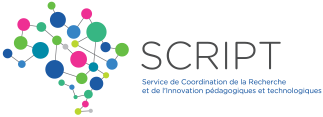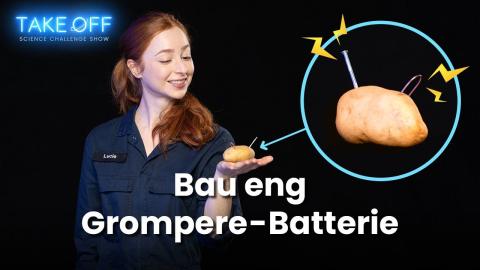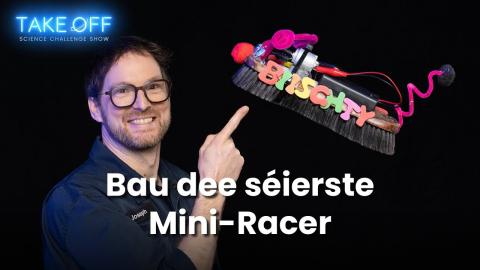Objective of the Challenge:
The goal of this Color Challenge is to find the recipe for a specific color in a systematic way. Students are to develop a recipe through structured experimentation and precise measurements, enabling them to mix the original color as accurately as possible.
Key details:
- Topic: Systematics, Art
- Duration: 60-100 minutes
- Teams: 4 people
Infobox
Take Off is a scientific science game show where 12 smart young adults tackle challenging tasks. In each episode, one contestant is eliminated. In the grand finale, the winner takes home a prize of €10,000.
The show airs on RTL, RTL Play, and YouTube. On Instagram and TikTok, you can find short, entertaining behind-the-scenes videos featuring the contestants and hosts.
Preparations and Materials
Material List
Per team:
- 3 liquid primary colors with high opacity (Red, Yellow, Blue), e.g., acrylic paints
- +/-10 small cups (e.g., plastic shot glasses) and spoons for mixing
- Syringes, scales, or measuring cups for precise dosing
- Art supplies (brushes, drawing paper)
- Paper towels and water containers for cleaning brushes
- Optional: 1 fan / hairdryer (multiple teams can share)
Preparation for the Challenge Master / Teacher
- Download a colorimeter app or use Carolina RGB for color determination
- Prepare color samples: The two colors that need to be mixed must be prepared first. This involves mixing two primary colors in different ratios. An example is shown in the video.
- These ratios (or recipes) should be written down and kept. The resulting colors should be applied to a piece of drawing paper and distributed to all teams.
Infobox
The challenge process is based on 4 steps that allow teaching the scientific method: 1. Question, 2. Hypothesis, 3. Experiment/Test, 4. Conclusion. The question is the actual challenge. Students intuitively formulate their hypotheses: How exactly do I best solve the challenge? What method seems most promising? This hypothesis is then tested in the experiment or competition. If different groups have different approaches, different hypotheses are tested. The result then shows which hypothesis was better.
Challenge Process
1.Question
What is the best method to determine an unknown color recipe?
2. Introduction and Hypothesis (5 minutes)
The students will be divided into groups of 4 and provided with materials as well as the two color samples whose recipes they need to discover. Each group should first discuss possible approaches and methods orally to solve the task, namely how they can systematically and precisely create different color mixtures. They will be reminded that the color may change slightly after drying.
3. Experiment: Determining the Recipe (30 minutes)
The groups will be further divided into pairs of two. Each pair will take one of the two colors and must find out, through various mixtures and tests, how much of each primary color is needed to reproduce the original color samples. An important aspect of the experiment is that students must work systematically.
4. Recipe Exchange and Re-mixing (5 minutes)
After 30 minutes, the two pairs within each group will exchange the recipes for their respective colors. The task now is to precisely replicate the recipe and prepare a sample for the Challenge Master (teacher).
5. Verification / Evaluation
Once the colors have dried, the accuracy of the color mixture will be verified using a colorimeter app.
The Colorimeter App
We tested the Colorimeter app and Carolina RGB, both of which give three values for each color: the RGB values (Red, Green, Blue). The newly mixed colors and the original will be scanned one by one and compared. The team whose two mixtures have the least difference from the original color samples wins.
The calculation can be done using a table, for example:
| Green | |||
|---|---|---|---|
| R | G | B | |
| Original Color | 50 | 160 | 100 |
| Student Color | 40 | 180 | 110 |
| Difference (absolute) | 10 | 20 | 10 |
| Total | 40 |
6. Discussion of Results
- Which methods were most effective?
- What could be improved for the next attempt?
Ideal Method:
For example, to reproduce the color green, they could always use the same amount of the primary color blue and vary the amount of yellow.
It’s important to note that quantities should be written down as precisely and systematically as possible. Students must ensure that the colors are mixed thoroughly, no contamination occurs, and that the colors are applied evenly. When the color mixtures have dried, they can be compared to the original color and the best recipe chosen (not before, as the colors will change slightly while drying).
Physics: Subtractive color mixing with the primary colors Yellow, Red, and Blue.

In this episode (starting at minute 16:36), the difference between subtractive and additive color mixing is explained, as well as how they work.
Subtractive color mixing is based on the theory that pigments or dyes absorb light at different wavelengths and reflect the rest. In this case, we work with the primary colors Yellow, Red, and Blue.
- Yellow and Blue: When yellow and blue are mixed, blue absorbs the red and green light components, while yellow absorbs the blue. The result is green, as the reflected wavelengths are in the green range.
- Red and Blue: A mixture of red and blue results in violet because blue absorbs the green components of light, and red absorbs the blue components.
- Red and Yellow: Mixing red and yellow creates orange because both colors absorb the green and blue light components while reflecting the red and yellow light components.
When all three primary colors (Yellow, Red, and Blue) are combined, the pigments absorb so many light wavelengths that the result is often a dark, brown, or gray color.
In commercial printers, a similar subtractive mixing process is used, but with the primary colors Cyan, Magenta, and Yellow (CMY). These colors are chosen based on the same principles but are selected to provide greater color accuracy and better print quality. In this process, Magenta replaces the traditional Red, and Cyan replaces Blue in printing technology.
Author: Joseph Rodesch (FNR)
Editor: Lucie Zeches (FNR)

Die Ausarbeitung dieser Rubrik wurde von science.lu in Kooperation mit dem Script (Service de Coordination de la Recherche et de l´Innovation pédagogiques et technologiques) durchgeführt.



